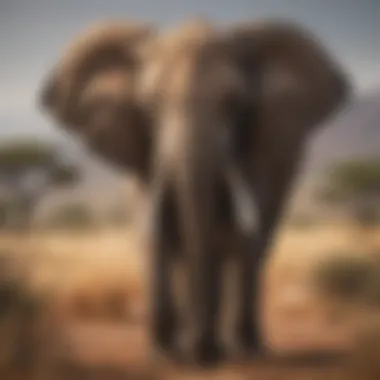Unveiling the Majestic Dimensions of African Elephants: A Detailed Exploration


Animal Species Profile
African elephants, the largest land mammals on Earth, have captivated the hearts and minds of people worldwide with their sheer size and unique characteristics. Their towering height, which can reach up to 13 feet at the shoulder, coupled with their massive weight of up to 14,000 pounds, sets them apart from other species. These majestic creatures are distinguishable by their large ears, long tusks, and wrinkled gray skin, which helps regulate body temperature and provide protection against the harsh African sun.
In terms of their natural habitat and distribution, African elephants are primarily found in sub-Saharan Africa, where they roam the savannas, grasslands, and forests. These intelligent creatures exhibit complex social interactions within their herds, which are matriarchal in nature. Led by the oldest and most experienced female, elephant herds form tight-knit bonds and communicate through a variety of vocalizations, body language, and infrasound.
Conservation & Wildlife Efforts
The conservation status of African elephants remains a cause for concern, as they face numerous threats to their survival. Illegal poaching for ivory, habitat loss due to human activities such as deforestation and agriculture, and conflict with local communities pose significant challenges to the species. However, various conservation initiatives and organizations, such as the African Wildlife Foundation and Save the Elephants, are working tirelessly to protect these magnificent animals.
Success stories in elephant conservation include the establishment of protected areas, community-based conservation programs, and anti-poaching efforts that have helped stabilize elephant populations in certain regions. These conservation efforts highlight the importance of promoting coexistence between humans and elephants, ensuring the long-term sustainability of these iconic creatures in the wild.
Animal Behavior & Psychology
African elephants exhibit fascinating behaviors and cognitive abilities that showcase their intelligence and emotional complexity. Communication among elephants is multifaceted, involving a combination of vocalizations, body gestures, and tactile signals. Through these forms of communication, elephants convey emotions, establish social hierarchies, and coordinate group movements.
Reproductive behavior in elephants is influenced by matriarchal leadership, with older females playing crucial roles in guiding younger members during mating and calf-rearing. Female elephants have lengthy gestation periods of about 22 months, and calves rely heavily on their mothers for protection and nourishment in their formative years.
Apart from their social dynamics and reproductive behavior, African elephants possess impressive cognitive abilities and problem-solving skills. Studies have shown that elephants demonstrate self-awareness, empathy, and the ability to use tools, highlighting their advanced cognitive capabilities.
Unique Facts & Trivia
Despite their massive size, African elephants are surprisingly agile and can reach speeds of up to 25 miles per hour when charging. These gentle giants have intricate memory systems that allow them to remember complex migration routes and recognize individual elephants even after years of separation.
Fun trivia about elephants includes their love for water and mud baths, which help regulate body temperature and protect against sunburn. Elephants also display quirky behaviors such as using their trunks to greet each other, playfully interact, and even comfort distressed herd members.
Record-breaking feats by elephants include their exceptional memory, with individuals capable of recalling past events and locations years after experiencing them. Additionally, elephants have a keen sense of hearing and can detect low-frequency sounds and infrasounds emitted by distant herds or approaching predators.
Pet Care & Tips
While African elephants are wild animals and not suitable as household pets, individuals can support elephant conservation through eco-tourism, donations to reputable organizations, and spreading awareness about the challenges facing these majestic creatures. It is essential to choose responsible tour operators that prioritize the well-being of elephants and their natural habitats.
Basic care requirements for pet elephants, including appropriate nutrition, veterinary care, and enrichment activities, ensure their physical and mental well-being in captivity. Training techniques based on positive reinforcement and respect for the animal's natural behaviors help foster mutual trust and strengthen the human-elephant bond.
Health and wellness tips for pet elephants emphasize the importance of regular exercise, mental stimulation, and social interaction within controlled environments. Enrichment ideas such as puzzle feeders, sensory activities, and socialization opportunities contribute to the overall welfare of captive elephants and promote their natural behaviors.


Introduction
A thorough understanding of the physical dimensions of African elephants is crucial in shedding light on the sheer size and unique characteristics of these magnificent creatures. This exploration will delve into the towering height and massive weight of African elephants, providing comprehensive insights into their physical magnificence. By uncovering the dimensions of African elephants, we aim to enrich our knowledge and appreciation for these iconic animals, highlighting the importance of their size in the ecosystem and society.
The Significance of Understanding Elephant Dimensions
Understanding the physical attributes of African elephants is essential for gaining a deeper insight into their biology and behavior. Delving into the specifics of their dimensions allows us to appreciate the uniqueness of each individual and the species as a whole. The insights into the physical attributes of African elephants offer a glimpse into their sheer magnificence, from their imposing stature to their structural adaptations. This understanding not only enhances our admiration for these animals but also contributes to ongoing conservation efforts by emphasizing the need to protect their habitats and populations.
As we explore the implications for conservation efforts, we uncover how a thorough understanding of elephant dimensions can directly impact conservation strategies. By recognizing the significance of size in relation to ecological needs and behavioral patterns, conservationists can tailor their efforts to effectively safeguard these majestic creatures. Understanding elephant dimensions is not merely an academic pursuit but a practical necessity in ensuring the long-term survival of African elephants in their natural habitats.
Overview of African Elephants
Brief Background
To grasp the essence of African elephants, a brief background on their evolutionary history and ecological significance is indispensable. Exploring their origins, habitat preferences, and evolutionary adaptations provides a holistic perspective on these remarkable animals. Understanding the historical context of African elephants enables us to appreciate their resilience and adaptability in a changing environment. Through a detailed exploration of their background, we gain a deeper appreciation for the intricate relationship between these creatures and their habitat.
Species Variations
A closer look at the variations within the African elephant species reveals the diverse characteristics and adaptations that exist among different populations. By examining these variations, we uncover the genetic diversity and behavioral nuances that distinguish one group from another. Understanding species variations not only enriches our understanding of African elephants but also underscores the importance of preserving this biodiversity for the species' long-term survival. By shedding light on these variations, we recognize the complex and dynamic nature of African elephant populations, emphasizing the need for tailored conservation strategies to address specific needs.
Physical Dimensions
When delving into the world of African elephants, understanding their physical dimensions is crucial. These majestic creatures boast impressive sizes, with their towering height and massive weight capturing the attention of researchers, conservationists, and wildlife enthusiasts alike. Analyzing the physical dimensions of African elephants provides valuable insights into their biology, behavior, and ecological roles. By examining their height, weight, body structure, and proportions, we can unravel the complexities of these iconic creatures and appreciate the unique features that make them stand out in the animal kingdom.
Height Comparison
Average Height of African Elephants
Exploring the average height of African elephants unveils an intriguing aspect of these majestic creatures. African elephants, known for their impressive stature, exhibit variations in height that contribute to their unique characteristics. The average height of African elephants serves as a prominent feature, differentiating them from other elephant species. This significant aspect sheds light on the evolutionary adaptations and genetic makeup that have shaped the iconic appearance of African elephants. Understanding the average height of these creatures provides essential information for researchers studying their biology and behavior.
Height Disparities within the Species
Height disparaties within the African elephant species further highlight the diversity and complexity present in these animals. Variations in height among individuals offer valuable insights into genetic factors, environmental influences, and social dynamics within elephant populations. Exploring the disparities in height sheds light on the adaptive strategies employed by African elephants to thrive in various habitats. By delving into these differences, researchers can gain a deeper understanding of the intricate mechanisms that drive the physical development and survival of these remarkable creatures.
Weight Variations


Average Weight Range
The average weight range of African elephants plays a crucial role in understanding their overall physiology and nutritional needs. These gentle giants exhibit varying weights that reflect their dietary preferences, age, and health status. The average weight range offers valuable data for conservationists and wildlife experts assessing the well-being of elephant populations in the wild. By examining the factors influencing weight variations, researchers can enhance their conservation efforts and implement targeted strategies to ensure the long-term survival of these magnificent animals.
Factors Influencing Weight Discrepancies
Factors influencing weight discrepancies among African elephants encompass a spectrum of environmental, physiological, and behavioral elements. From food availability and habitat quality to social interactions and reproduction patterns, various factors can impact the weight distribution within elephant populations. Investigating these influences enables researchers to grasp the interconnectedness of elephant ecology and behavior, facilitating informed conservation decisions and management practices.
Body Structure and Proportions
Insight into the Physique of African Elephants
Gaining insight into the physique of African elephants reveals the intricate details of their anatomy and biomechanics. The robust body structure of African elephants exemplifies their evolutionary adaptations and survival strategies honed over millennia. Exploring the physique of these magnificent creatures unveils the remarkable features that contribute to their iconic appearance and functional versatility in diverse habitats. Appreciating the nuances of their physique enhances our comprehension of the evolutionary trajectory and ecological significance of African elephants.
Notable Body Features
The notable body features of African elephants encompass a myriad of distinct traits that set them apart in the animal kingdom. From their elongated trunks and massive ears to their tusks and unique foot structures, each body feature serves a specific purpose in the lives of these gentle giants. Analyzing these notable features offers profound insights into the evolutionary history, sensory capabilities, and social behaviors of African elephants. By highlighting these anatomical marvels, we can marvel at the complexity and beauty of nature's designs in these magnificent creatures.
Comparative Analysis
Contrasting African Elephants with Other Elephant Species
Differences in Physical Size
Exploring the aspect of Differences in Physical Size between African elephants and other elephant species is essential in understanding the sheer magnitude of variations that exist within the elephant family. African elephants, known for their impressive size and stature, showcase unique physical dimensions that distinguish them from their Asian counterparts. The key characteristic of Differences in Physical Size lies in the height and weight variations observed across different elephant species. This distinction plays a pivotal role in defining the overall appearance and structure of African elephants, setting them apart as the largest land mammals on Earth. By elucidating these differences in physical size, this article aims to shed light on the evolutionary adaptations and ecological niches that have contributed to the diverse forms of elephants worldwide.
Behavioral Implications
Delving into the Behavioral Implications of African elephants compared to other elephant species unveils intriguing behavioral patterns and social dynamics inherent to these majestic creatures. The key characteristic of Behavioral Implications lies in the complex interactions, communication methods, and social hierarchies prevalent among African elephants. Understanding how these behavioral traits differ from those of other elephant species offers valuable insights into their adaptive strategies, mating behaviors, and response mechanisms to environmental stimuli. By examining the behavioral implications of African elephants within a comparative framework, this article provides a nuanced perspective on how behavioral traits influence their survival, reproduction, and coexistence within diverse ecosystems.
Importance of Size in Elephant Society
In the vast landscape of elephant society, size plays a pivotal role in shaping hierarchical structures and interactions among these majestic creatures. The significance of size within the elephant community is profound, influencing various aspects of their behavior, relationships, and overall dynamics. Understanding the importance of size in elephant society offers invaluable insights into how these animals navigate their social environments, establish dominance, and ensure their survival in the wild.
Social Hierarchies


Size Influence on Ranking
Delving deeper into the intricate tapestry of elephant social hierarchies unveils the intricate relationship between size and dominance. Size significantly impacts how elephants establish their rank within the herd, with larger individuals often commanding higher positions. The sheer physical presence of larger elephants instills a sense of authority and power, enabling them to influence group decisions, mating opportunities, and resource access. This size-based ranking system reflects the natural order within elephant societies, where size directly correlates with leadership and decision-making capabilities.
Role of Dominant Individuals
Within the framework of elephant society, dominant individuals play a crucial role in maintaining order, resolving conflicts, and ensuring the herd's cohesion. The role of dominant elephants extends beyond physical prowess, encompassing wisdom, experience, and strategic thinking. These dominant individuals, often the largest and oldest members of the group, guide the herd through challenges, protect vulnerable members, and lead migration efforts. Their authority is derived not only from their size but also from their ability to command respect, instill discipline, and foster a sense of unity among group members. The presence of dominant elephants underscores the importance of leadership in elephant society, showcasing how size translates into influence and responsibility.
Reproductive Significance
In the realm of elephant reproduction, size influences various aspects of mating behavior, partner selection, and offspring survival. The reproductive significance of size sheds light on the complex dynamics of elephant breeding strategies, genetic diversity, and species propagation within their natural habitats.
Mating Preferences
Exploring the nuances of elephant mating preferences reveals how size plays a critical role in determining reproductive success and genetic fitness. Female elephants often show a preference for larger, stronger males during mate selection, as size is linked to genetic quality, health, and survival attributes. Male elephants with impressive size and stature are more likely to attract female partners, engage in successful mating encounters, and contribute desirable traits to the offspring. This preference for size in mating highlights the evolutionary significance of physical dimensions in ensuring the success and sustainability of elephant populations.
Offspring Survival
The survival of elephant offspring is intricately tied to the size and characteristics of parental individuals, shaping the survival prospects and growth potential of young calves. Larger adult elephants, especially females, provide vital protection, nourishment, and guidance to their offspring, enhancing their chances of survival in challenging environments. The robust size of elephant mothers offers a protective shield against predators, rival males, and natural hazards, safeguarding the vulnerable young ones until they can fend for themselves. Offspring born to larger, more dominant elephants benefit from superior care, social integration, and learning opportunities, ensuring a higher survival rate and future reproductive success within the elephant community.
Human-Elephant Interactions
In the realm of exploring the vast dimensions of African elephants, the facet of human-elephant interactions emerges as a crucial area of study. These interactions play a significant role in shaping the dynamics between these majestic creatures and human populations. Understanding the complexities of human-elephant interactions provides insights into cohabitation strategies, conservation efforts, and ecosystem management.
Conflict Scenarios
Human-Elephant Encounters
Diving deeper into human-elephant encounters uncovers the nuanced nature of these interactions. From peaceful coexistence to instances of conflict, human-elephant encounters reflect the intricate relationship between these two species. The key characteristic of such encounters lies in the potential for both conflict and cohabitation. It is crucial to analyze the factors influencing these encounters, such as habitat fragmentation, human encroachment, and elephant behavior, to mitigate negative outcomes. Understanding the behavioral patterns of elephants and community dynamics is essential to fostering harmonious relationships between humans and elephants. While human-elephant encounters present challenges, they also offer opportunities for learning and implementing sustainable conservation practices.
Mitigation Strategies
Mitigation strategies form a vital component of managing human-elephant conflicts and promoting peaceful interactions. These strategies encompass a range of approaches, including physical barriers, early warning systems, and community engagement initiatives. The key characteristic of effective mitigation strategies lies in their ability to balance human needs with elephant conservation. By implementing robust mitigation measures, such as elephant-proof barriers or alternative livelihood programs for communities living near elephant habitats, conflicts can be minimized, and coexistence can be facilitated. The unique feature of mitigation strategies is their adaptive nature, requiring continuous assessment and adjustment to suit evolving environmental and social dynamics. While mitigation strategies come with their set of challenges, their advantages in fostering peaceful human-elephant interactions make them indispensable tools in conservation efforts.
Cultural Perceptions
Symbolism in Different Cultures
Exploring the cultural perceptions of elephants unveils the profound symbolism these creatures hold across diverse societies. Symbolism in different cultures reflects varying beliefs, traditions, and values associated with elephants. The key characteristic of elephant symbolism is its multi-faceted nature, representing themes such as wisdom, strength, and spirituality. In this article, delving into the significance of elephant symbolism enhances our understanding of the symbolic narratives woven around these majestic beings. Understanding how different cultures perceive elephants offers valuable insights into the intrinsic connections between humans and these iconic animals.
Historical Reverence
Examining the historical reverence for elephants sheds light on the enduring legacy that these animals carry throughout history. Historical reverence signifies the deep-rooted respect and admiration that elephants have garnered over centuries. The key characteristic of historical reverence lies in its portrayal of elephants as symbols of power, intelligence, and cultural significance. By delving into the historical narratives surrounding elephants, this article delves into the rich tapestry of human-elephant relationships, highlighting the timeless bond that has shaped cultural narratives and societal beliefs. Understanding the historical reverence for elephants provides a glimpse into the profound impact these creatures have had on human civilization.







